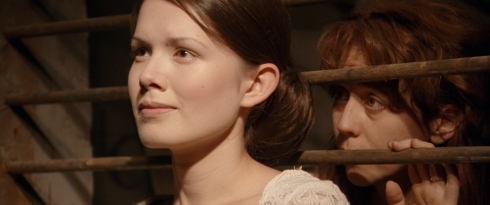
Grace Vallorani (behind bars) with her captor, played by Constance Carter, in The Power
One of the joys of a film festival like London’s Raindance is you don’t know what you’re going to get: films often arrive with no reviews or advance buzz, which makes any happy discoveries seem the more exciting. I went to the UK Premiere of The Power after a chance conversation with the lead actress, Grace Vallorani, at the poker table (where you meet all the most interesting people!). It was a revelation. Vallorani gives a performance of astonishing power, bravery and openness, completely lacking in actorly vanity, that richly deserves a wider audience.
The film itself is not without flaws: primarily from its mismatch of genres. For the most part, it’s a very successful psychological thriller in which a woman is kidnapped and held prisoner to nefarious ends. Vallorani’s distress is grippingly, viscerally real: as she screams and batters the iron bars of her cell, you genuinely fear she’s done herself an injury.
In fact, Vallorani revealed at the Q&A interview session after the film, she had: “All the bruises, the blood on my head, they were all real. I hit my head on the bars.” Afterwards, she demonstrated how the little finger on her right hand is crooked – she cracked that on the bars, too, without realising it at the time.
The cell scenes were shot over the course of 12 days, with the barest of scripts – most of the dialogue was improvised to seem more naturalistic, which works well. For that whole time, while the rest of the cast were resting in their dressing rooms or tucked up in hotel beds, Vallorani actually lived in the cell: nights included. Her character spends her days trying to scrape out the concrete housing around the metal bars with a single nail in order to escape. That, too, the actress did for real.
It’s an extraordinary level of commitment to bring to a part, which shows in the integrity of her performance. What stops these scenes – the bulk of the movie – becoming samey is her character’s developing relationship with the girl who brings her food. Constance Carter, in her film debut, is excellent as the daughter of a cult leader: initially impervious to argument and parroting the mantras she has been taught, her façade begins to crumble as Vallorani alternately shouts, pleads, flatters, threatens, cajoles, reasons and, finally, befriends her.
The scenes between them are genuinely touching, as Vallorani comes to realise that both women are equally captives: it’s just that for Carter’s character, the bars are in her mind.
If writer/director Paul Hills had fully trusted in his cast, and the strength of the material he had here, he might have bequeathed an intelligent and sensitive psychological thriller. However, it also lurches uneasily into horror territory, with a baby-sacrificing, heart-eating, Baphomet-worshipping cult thrown in. This part is, for me, logistically implausible and psychologically risible, despite the extensive research Hills apparently did into the subject, while the ending contradicts the terrific character work built up over the course of the film.
Even so: perhaps all that will be more to someone else’s taste than mine; and the bits that are good in the film – the vast majority, in fact – are very good indeed.

Leave a comment